| West
Virginia foray |
Fores-@aol.com |
| Mar
27, 2006 05:32 PST |
ENTS:
We had a successful trip into the WV woods on Saturday and
Sunday. Carl and
Tony came down from PA and met with me and Mike Plevich, a
forester from
Morgantown, WV to look at some decent trees in Alum Bridge, WV.
I am pretty certain that either Carl or Tony will provide some
stats on
trees measured but the tallest red oak in Lewis County was
around 145'.
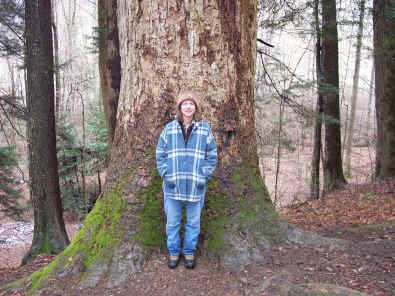
Amy Cimarolli at Widen Poplar
On Sunday, Carl, Tony Mike and myself were led to the Widen
poplar in Widen,
WV by Amy Cimarolli who is a conservation ecologist for the
Nature
Conservancy in WV. The poplar was over 170' tall.
Sunday was snowy and quite miserable as the trees shed their
coating of
slushy snow on everyone.
We were able to get more than ten species at each site so I
think that Carl
is going to try to develop a Rucker Index for the sites we
visited.
Russ Richardson
|
| West
Virginia foray |
Carl
Harting |
| Mar
29, 2006 19:47 PST |
Ents,
Anthony Kelly and I traveled to West Virginia last Friday March
24th
to meet
Russ
Richardson and see some of the trees heís been writing
about.
We
arrived early Friday afternoon and while waiting for
Russ to get home from work we drove to Cedar Creek State Park
and
walked around a hillside in the south central section of the
park.
While we didnít measure anything we found some decent tulips
and a nice
yellow buckeye along the trail. This walk gave
us a chance to familiarize ourselves with trees that we donít
see often
in Pennsylvania. Its not surprising we didnít find any tall
trees here,
since according to Russ most of the impressive West Virginia
trees are
located on private land. Upon returning to Russí property we got a tour
from the man himself - let
me just say
how jealous I am of his Crummies Creek tree farm! Hundreds of
acres of
cove forests with hardly a neighbor in sight. Unbelievable!
Saturday morning we headed out along the stomach churning curves
of Rt.
33 to the village of Alum Bridge to a property Russ had marked
for
logging about 6 years ago. As we pulled up below the west facing
ridge
we could see a large red oak poking out of
he lower forest canopy and an impressive hickory on the top of
the
ridge. Joining us here was Mike Plevich, a Natural Resource
Specialist
at the Army Training Site Camp Dawson. Mike assisted with tree
ID and
location on both Saturday and Sunday. The first
tree we measured was the big red oak which turned out to be
13.9x133.8 (unfortunately not 145 as Russ wrote earlier). It
grew in a
cluster of 3 red oaks, the second tallest of which was
11.8x122.4. As
we pushed on up the hillside we measured a couple
tulips along the logging road, the tallest of which was 142.6.
After
nearly crawling up the steep hill (Russí dogs climbed up ahead
of us and
sat together on a rock to show us how easy it is to climb with 4
feet)
we got to the hickory at the top which
turned out to be a pignut measuring 7.7x132. We moved along the
ridge
top to some other big trees Russ remembered, but 2 of the most
impressive (a tulip and chestnut oak) turned out to have died or
broken
since his last visit.
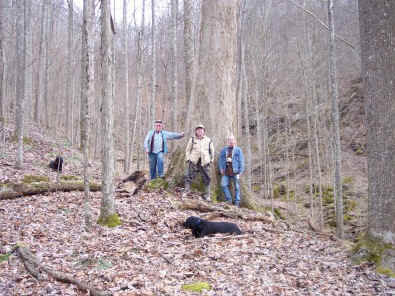
Russ Richardson, Tony Kelly and Carl Harting at base of 14.0
CBH Cucumber
Walking the timber roads
gave ample evidence of the invasives introduced to the site
recently
including Japanese stilt grass and tree of heaven. Tree
regeneration
was non-existent under the dense brown cover of dead stilt
grass. A
recent gas well access road also destabilized the
hillside and many areas had slumped downhill. Next we drove
around to
the far side of the property where we sampled more trees
including a
14.0x80+/- cucumber cull and a classic white oak wolf tree at
14.7x99.2.
Alum Bridge, WVA
Species
CBH
Height
N Red Oak
13.9 133.8
N Red Oak 11.8 122.4
Tulip
12.3 132.5
Tulip
12.0 130.9
Tulip
n/a 142.6
Tulip
n/a 137.7
Pignut Hickory 7.7 132.0
White Ash 6.9
120.8
Pignut Hickory 9.4 126.4
Am Beech 7.5
103.3
White Oak 8.4
106.8
Chestnut Oak 10.3 107.7
Am Basswood 5.7 99.7
Sugar Maple 6.2 101.7
Black Oak n/a
100.5
Tulip
9.8 118.3
Tulip
n/a 121.6
Shagbark Hick. 4.1 99.8
Bitternut Hick. 6.5 106.7
Tulip
9.4 114.8
Am Basswood 5.9 85.1
Cucumber
7.1 91.3
Butternut
4.5 65.3
Sycamore
n/a 100.4
------------------------------------------
tulip
12.9 127.0
Red Oak
12.3 131.1
Am Basswood 10.2
120.3
Shagbark
6.0 121.5
Black Gum
6.9 91.4
Yellow Buckeye 9.1 106.6
Cucumber
14.0 80+/-
White Oak
14.7 99.2 wolf tree
Am Basswood 7.0
115.8
Black Cherry
7.6 106.7
Hemlock
n/a 102.4
Black Cherry
3.5 82.2
**Alum Bridge Rucker Index **
Tulip
142.6
N Red Oak 133.8
Pignut Hickory 132.0
Shagbark Hick. 121.5
White Ash 120.8
Am Basswood 120.3
Chestnut Oak 107.7
White Oak 106.8
Black Cherry 106.7
Yellow Buckeye 106.6
Rucker Index 119.9
Sunday we met Amy Cimarolli, a conservation ecologist with the
Nature
Conservancy, who would guide us to the Widen Poplar. After
driving a
few miles of logging roads in light snow and fog we descended
into a
wide valley stripped on both sides from the river to about the midpoint
of each ridge.
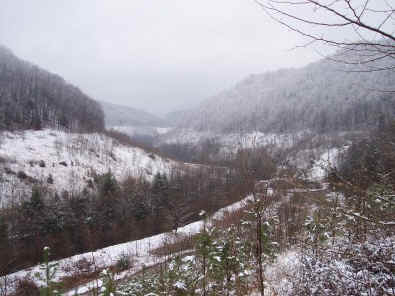
Stripped valley at Widen, W. Va.
While most of the
valley
bottom was the typical grass/planted pine mix typical of strip
mined
areas, there was a small 5-10 acre area of forest that, while
not
untouched from a timber perspective, had been spared by
the coal company to protect the incredible tulip tree growing
within.
The Widen Poplar grows near the valley bottom facing west to
northwest,
up a small rise from an old building foundation littered with
beer
bottles, and nearly surrounded by ATV trails
s. Growing on the edge of the hill the roots of the tree have to
be
impacted by the ATVs - some sort of protection needs to be put
in place
to save this tree from destruction. Maybe Mike and Amy will be
able to
get a partnership together to at least g
some fencing up. There were 2 holes at the bottom of the trunk
filled
with cement, so there is some rot present, and the crown had a
couple
large branch stubs so the tree was probably taller in the past.
We took
numerous height measurements to be sure
of accuracy and eventually decided on 17.7x173.2.
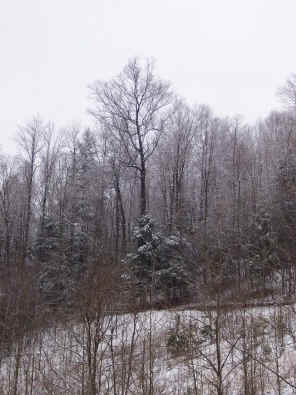
Widen Pignut 8.6x134.5
Another impressive tree that grows on the edge of the older
forest
remnant was a pignut hickory that stood above the canopy and is
actually
the first tree you notice as you drive down into the valley.
This tree
proved a challenge to measure but after
moving from above and out in the field and using Amyís hand as a
laser
target we agreed on 8.6x134.5. After measuring the crown spread,
which I
did not record, it comes up only 4 points shy of the champion
W.Va.
pignut, but with a more accurate measurement
of the current champís height this one may come out on top.
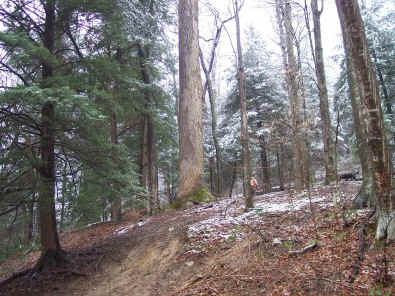
Base of Widen Poplar
As an additional exercise Mike Plevich measured the height of
the Widen
Poplar and the pignut hickory with just his clinometer and a
distance
from my rangefinder. From various views the poplar gave him a
range
from 166í to 187í with his final answer at 183í.
The WV register of big trees lists the Widen Poplar at
195í, so
itís only listed 22 feet too high.
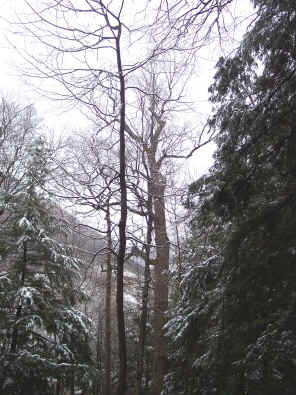
Top of Widen Poplar
The pignut gave an even
bigger
range, all on the high side, from 140í to 165í. Mike also
measured the
132 ft pignut on Saturday and did much better,
getting 129.8ft. This was a fairly straight tree on level
ground.
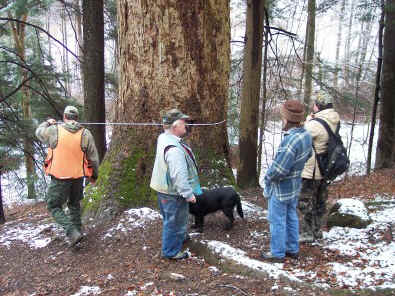
Mike Plevich, Russ Richardson, Amy Cimarolli and Tony Kelly
at Widen Poplar
Iíll forward some pictures to Ed to put on the website, and
Iím sure
Anthony and Russ will have additional comments.
Widen, WVA
Tulip
17.7 173.2 Widen Poplar
Am Beech 8.4
129.0
Am Basswood 5.4 120.5
Sycamore 4.8
113.0
Black Gum 6.7
111.8
Red Maple 5.9
106.5
Am Basswood 5.3 118.4
Sugar Maple 4.8 109.1
Pignut hickory 8.6 134.5
N Red Oak 7.9
113.9
Am Basswood 4.4 116.6
Black Cherry 5.2
110.7 Double
Cucumber 4.1
107.0
White Ash 4.0
106.3
Tulip
5.6 121.7
Tulip
6.1 122.2
Hemlock
6.1 109.5
**Widen Rucker Index**
Tulip
173.2
Pignut Hickory 134.5
Am Beech
129.0
Am Basswood 120.5
Sycamore
113.0
N Red Oak
113.9
Black Gum
111.8
Black Cherry 110.7
Hemlock
109.5
Sugar Maple 109.1
Rucker Index 122.5
Carl Harting, Anthony Kelly and Russ Richardson
|
| Congratulations
on the WV foray |
dbhg-@comcast.net |
| Mar
28-29, 2006 05:10 PST |
Russ,
That's great news on the Widen tuliptree. We now have tulips in
NC, SC, TN,
and WV over 170 feet tall. I think that's the list.
Will or Jess will correct me if
I'm wrong. But that is simply
way cool. Way cool! The oak isn't too shabby either.
Congratulations to all of you.
Carl and Anthony,
Congratulations! The two of you should earn a special ENTS tree
measuring award. Not only have you confirmed some incredible
West
Virginia trees, but you've also gathered extremely valuable
information
on important mis-measured trees. The erroneous 195-foot height
for the
Widen tuliptree provides the kind of accounts that lead to
reporting
200-foot talle tulips. It is interesting how we are confirming
that the
tree can creep up toward 180 feet, but we still haven't
confirmed a 180.
I wonder if Lee's hypothesis kicks in here, i.e. height
limitations due
possibly to vessel size?
Bob
Bob
|
| RE:
West
Virginia foray |
djluth-@pennswoods.net |
| Mar
29, 2006 20:38 PST |
Carl, Tony, & Russ,
Great job documenting these trees. The Widen Poplar is a dandy.
17.7ft
CBH x 173.2ft high?! AWESOME !!!!!
I like your hickory and buckeye stats. I get into so very little
of
these up here.
Wish I could've been with you guys.
Dale
|
| RE:
Carl and Anthony Score Big Time |
Anthony
Kelly |
| Apr
01, 2006 15:42 PST |
Bob,
Sorry it's taken me so long to respond. Thank you for
congratulating Carl
and I on our measuring the Widen Poplar. I don't know that a
special ENTS
tree measuring award is really in order, though. As Carl was
saying
Thursday to Dale and I at Cook Forest, measuring a giant tree is
the easy
part. Finding it is the hard part. We were led right up to the
Widen
Poplar. (Thanks go to Amy Cimarolli of the West Virginia Nature
Conservancy
for that.) We were just lucky enough to be the first to measusre
it using
laser rangefinders and the double sine method.
I'd like to make a few comments on the tree not measuring up to
the 195'
listed in the West Virginia Register of Big Trees. As Carl
mentioned in his
report posted Wednesday, their are some very big branch stubs
near the top
of the tree indicating that it was almost certainly taller in
the past,
perhaps much taller. You can kind of get an idea of this from
the photo of
the top of the tree now posted on the ENTS web site. In the
photo you can
see what looks like a bulge about 3/4 up the trunk.
http://www.nativetreesociety.org/fieldtrips/west_virginia/widen/west_virginia_foray.htm
Though the photo posted perhaps doesn't show this very
convincingly, a major
portion of the trunk appears to have broken off many years ago
at this area
where the main trunk is still very thick. Pretty much the whole
top of the
tree must have come down. Since then branches have grown up from
the break
area to form the new crown. This new growth probably amounts to
maybe 30 or
so feet of height with the thickness of the new braches not
nearly as thick
as those that broke off. My guess is that this tree was at one
time easily
over 180' tall. (By the way, none of this is April Fool's
mischief!)
I'm not an expert, but aside from what you said in your post
(below) about
height limitations due to vessel size and the fact that no tulip
poplar has
yet been found to breech the 180' mark, I have to say that if
ever there was
a +180' tulip poplar the Widen Poplar was probably it.
You even have to wonder about the 195' measurement. The scars at
the
breakage point looked old, so my guess is that that measurement
was probably
made after the breakage and the error is to classic tangent
method error.
Still I wonder.
Carl and I were saying Thursday that, in hindsight, we should
have taken
many more detailed measurements of the tree besides height. With
the rain
and the melting snow falling on us in clumps from the trees we
were just
pre-occupied with getting the height right. (And I have to say
we did feel
some pressure on us to get it right!) It would have been nice to
know how
high the tree is at the breakage spot. Neither of us, of course,
have an RD
1000, but it would have been nice to see how thick the trunk is
at that
point (pretty thick). (We did take the height to the first
branch. I
remember it being around 80'.)
I don't know how much mathematical modeling has been done on
tulip poplar
shape and growth, but it would be interesting to take width
measurements of
the tree at different points up to the breakage point, plug the
numbers into
a model and project what the height of the tree might have been
while it was
still intact. Do any such models for tulip poplar shape and
growth exist?
Dang! I could kick myself now for not getting the height of the
breakage
point! That and width measurements will have to wait for a
future ENTS
visit to the tree. I really hope that you, Bob, and some of the
more
knowledgable and experienced ENTS -- Will, Jesse, etc. get to
see and
measure this tree while it's still standing. I'd really like to
hear your
opinions on what the pre-breakage height of this tree might have
been. Put
this one way up near the top of your lists guys. It's a real
doozy!
Anthony Kelly
|
| RE:
Carl and Anthony Score Big Time TULIPTREES |
Will
Blozan |
| Apr
02, 2006 11:45 PDT |
Anthony, Carl, ENTS,
I have certainly experienced your enthusiasm (and regrets- Damn,
why didn't
I...) about measuring a significant tree. I am impressed with
the lack of
taper and huge trunk of the tree. However, I would like to
discuss the
tuliptree as we currently know it. I have had the privilege of
climbing some
of the huge ones in the Smokies and measuring thousands down
here in the
southern Appalachians.
As far as the suspected 180' height threshold for the species, I
still
believe it will hold, at least with the current population of
trees we have
to study. ENTS has found about 80 tuliptrees that reach over 170
feet. All
but a half dozen or so are in the Smokies (Jess and I added one
in SC last
Wednesday- 177.5'). Of the known trees over 170', only 4 exceed
177'. Of
these trees, ALL are less than 120 years old and have very slim
tops.
Some of the tallest old trees, 7' thick and 4000 cubic feet
volume, have
huge, massive tops on them (see the Sag Branch climb photos on
the ENTS
website). I still don't believe the trees were ever much taller
than they
are now. The Sag Branch tree is currently 168' tall, and has
trunk wood over
a foot in diameter just 20 feet below the canopy. There are big
breaks and
huge stubs up there indicating the tree has been tall for
centuries. Still,
it likely never exceeded 170' in its life and probably never
will.
I'm not saying the Widen Poplar wasn't ever taller; it is just
very unlikely
it was over 180' based on what we currently know. Admittedly, we
do not know
squat about West Virginia's tuliptrees and what they do on good
sites-
except the one tree ever measured. The state holds huge
potential and really
needs an ENTS representative to shed light on the gems growing
there! From
what I can recall, thus far there has been but three trips to
the state;
Cathedral State Park, Webster Springs and your trip.
Speaking of trees in WV that need a return visit, the Webster
Springs
Sycamore needs to be reticled for volume before it falls and
implodes on
itself. That tree, with its HUGE trunk break, was likely over
160' at one
time, considering the remnant branch that remains is over 144'
high.
Will |
| RE:
Carl and Anthony Score Big Time TULIPTREES |
wad-@comcast.net |
| Apr
02, 2006 18:31 PDT |
Will
When you climbed some of the big tulips, did you ever measure
the annual growth up at the tips? How many inches does a big
tree put on annually? Does that amount of growth reduce as the
tree gets really big? For instance, say a young tulip can put on
three feet of new growth in one season in it's first few years.
Does that then decrease over time to where it basically
"leafs out" and puts on a 1/2" at the top when it
is huge? Just curious. Just for gambling purposes, but I think
they will reach 180' somewhere.
Scott
|
| RE:
Carl and Anthony Score Big Time TULIPTREES |
Robert
Leverett |
| Apr
03, 2006 05:12 PDT |
Scott,
Good questions. Will will have to answer them for the
tuliptrees, but
seevral of us will have input on white pines. With the
Macroscope 25, we
can now measure new growth at the top of the tree to an accuracy
of
about a half inch or slightly less. The trees in MTSF that are
in the
100 - 150 year age class are currently growing at the rate of 8
to 13
inches per year. I think silviculturists commonly expect to see
4 to 6
inches new growth for trees in that age class.
Bob
|
| RE:
Carl and Anthony Score Big Time TULIPTREES |
Will
Blozan |
| Apr
03, 2006 06:02 PDT |
Scott,
The big ones are not growing 3 feet of course; I would suppose
3-6 inches.
Of course, that growth is spread over numerous branches so a
single tree may
be gaining dozens of feet in annual height any given year. The
younger trees
over 170 feet still appear to be growing 8-12 inches per year,
and Bob
Leverett and I have monitored the tulips in Baxter Creek and
have "watched"
as several have entered the 170' height class by putting on over
1 foot a
year. The second tallest tree in the Smokies, a 177.1 foot tree
in Big
Creek, grew about 11 inches the previous year. I haven't
measured it yet
this spring but plan to see what happened last year! We did have
a freeze
that killed all the leaves last spring but I doubt it seriously
slowed them
down. I expect it to be close to 178' now. Of course, the height
champ, the
"Rucker Tuliptree", needs a revisit. I went there with
Jess and John
Eichholz last month but it was too foggy to get a shot to the
top!
Yes, a 180' tree is out there. Jess and I measured a 177.5' tree
in South
Carolina last week that has an absolutely perfect, single
leader, and is
very young. That tree or the Big Creek tree above will likely be
the first
to grow to 180', but we may find one before then.
Will
|
| RE:
Carl and Anthony Score Big Time TULIPTREES |
wad-@comcast.net |
| Apr
03, 2006 06:38 PDT |
Will
Sounds like we will have some 180's in three years or less! Do
you have a height limit in mind for tulip? Guesstimate?
Do you have much experience with Dawn redwood? I know it is not
a native Eastern tree, and it is only known by fossil record in
the west, but I measured a tree that was planted in the 40's,
from the initial batch from the rediscovery in China, that is
125'+. I am thinking this tree will be a height champion for the
east coast someday. I have one in my yard that has put on three
feet or more each year for the past eight years. Almost all of
the original trees that I have measured are over 100'. Just
something to think about!
Scott
|
| Back
to Anthony |
Robert
Leverett |
| Apr
03, 2006 06:40 PDT |
Anthony,
Thanks for the excellent summary. You guys are
the greatest! I
sympathized with your kicking yourself for not having gotten
other
measurements while at the tree. That is an occupational
challenge we all
live with. I have failed to take that additional measurement or
two more
times that I care to remember. I'm often in the forest with
groups and
have limited time. I am forever frantically trying to grab
measuring
moments.
Sometime this summer, I'd like to visit the
poplar with you all, if
we could work out a date. Maybe we can take the extra
measurements. I
would bring both the RD 1000 and the Macroscope 25 to measure
diameter
aloft. We could model the volume of the tree for historical
purposes.
It is exciting to think of the Widen poplar as
having been 195 feet
tall at one time. No way of knowing, but we can dream. It is
interesting
that we just can't seem to break 180 on that species and it
isn't for
lack of looking. I think a few 190s did exist in the past, but
probably
only as statistical outliers, rather like the 8-foot tall circus
man, if
a human analogy is valid.
Don Bertolette makes good points about loss of
genetic diversity and
that might figure in. Bruce Allen speaks to atmospheric
pollution as a
possible source of adverse impact on the tallest trees. But
regardless,
we need to get the best that remains documented before the
standard for
judging excellence undergoes another reduction.
Bob
|
| Re: |
Jess
Riddle |
| Apr
03, 2006 07:28 PDT |
Carl, Anthony;
Great report. What you found starts to fill some big holes in
the
ENTS database, and having measurements from the northern end of
some
species' ranges, like yellow buckeye, is nice. The Widen Poplar
is
certainly the surprise of the trip. Tree crowns are so variable
that
determining the height of a missing section for an individual
tree may
always be beyond our capabilities. Nonetheless, the 173.2'
figure is
extremely impressive; thanks for taking the time to get good
measurements.
Jess
|
| RE:
Carl and Anthony Score Big Time TULIPTREES |
Anthony
Kelly |
| Apr
03, 2006 20:56 PDT |
Will,
I guess I based my speculations about the Widen Poplar's
possibly once being
+180' on everday, layman's assumptions about what younger broken
trees might
have looked like before being damaged.
I'll try to explain. Let's say we see a younger, but sizable,
tree that had
at one time been broken completely off at some place where the
trunk was
still relatively thick. We also see that this tree has grown a
newer top
from the breakage point. This new top has branches that, at
their base, are
thinner than the original trunk. The new growth adds say 15' of
height.
Our eye and mind tend to do a quick extrapolation and fill in
what the
original tree might have looked like (height, crown spread,
etc.) based on
our past experiences seeing many other similar trees with
comparable trunk
sizes at that height. Though there is a great deal of
variability in how
individual trees grow and how this actual tree might have
looked, the
speculative tree in our mind's eye would tend toward normative
dimensions.
Such images would probably be fairly accurate much of the time.
The more
trees of a species (and location and growing conditons, etc)
that we are
familiar with the more accurate our speculative image would tend
to be.
Now, when dealing with a tree like the Widen Poplar that is at
or near it's
height potental, additional constraints would apply, and a
common-sensical,
off-the-cuff extrapolation like the one described above based on
assumptions
about younger trees would likely be erroneous.
Because the Widen Poplar has so little taper up to the break off
spots, it's
easy to fall into the trap of assuming that it must have
originally grown
straight tapering at the same rate from its current thickness to
a point
where the trunk was thin resulting in an incredibly high tree.
Of course, the tree may have reached a height at or about its
current height
years before it achieved it's current thickness. If a <180'
max height
limit due to vessel size or some other constraining factor has
been
operating on the tree, would the trunk have continued to grow
thicker and
thicker over the years as successive tops came and went?
Boy, I'm just ruminating away here. Am I any making any sense at
all?
I guess what I'm trying to say is: I get your point. You've seen
alot of
170+ Tulip Poplars than me, so you're the better judge.
Anthony Kelly
|
| Re:
Carl and Anthony Score Big Time TULIPTREES |
Fores-@aol.com |
| Apr
04, 2006 06:55 PDT |
Ents:
When we were at the Widen poplar, Mike Plevich and I were trying
to estimate
the diameter of the trunk at various heights. Because the tree
had so
little taper I was trying to determine whether this tree would
fit in a form class
(for timber volume determination based on taper) that would be
close to the
maximum of 90. For comparison, an old, slow growing western Mass
or Vermont
hemlock with an ice cream cone shaped taper would be a FC 65 or
67 tree. It
would be wonderful to have some additional measurements as my
best guess is
that at the first branch in the Widen poplar (85') the trunk is
still more
than 36" in diameter and where the trunk breaks into the
large branches that
make up the current top at around 126' the diameter should be
close to 2 feet.
I think that what has intrigued me the most about some of the
discussion is
that the Widen poplar is located at the western edge of a three
or four
thousand square mile area that represents the most productive
forestland in West
Virginia. From what I saw when we were measuring the Widen
poplar and what I
know to exist in other parts of the state I would say it should
almost be a
certainty that there are several second growth poplars pushing
or exceeding
180'.
I will do some polling among people I know in WV to see whether
I can get
any consensus on where the tallest poplars grow. Personally, I
have witnessed
several trees harvested that were under 30" DBH (7.8' CBH)
and had a straight
stem that tapered to a 10-12" diameter tip over 125' from
the stump.
I am growing curious about the size of some of the other
"named" trees in
the woodlands of WV, especially a red oak tree that monuments
the intersection
of Clay, Kanawha and Roane Counties.
Russ |
| RE:
Carl and Anthony Score Big Time TULIPTREES |
Robert
Leverett |
| Apr
04, 2006 08:04 PDT |
Russ,
I'm excited by what you all have confirmed in
WV. You've been telling
us for years how productive some of the WV sites are. I
absolutely want
to visit you later this year. Maybe by then you'll have
identified
several fertile sites growing tuliptrees that rival any that
we've
confirmed elsewhere.
Bob
|
| Widen
Poplar Volume |
Will
Blozan |
| Apr
09, 2006 10:57 PDT |
ENTS,
I must retract my initial estimate of the Widen Poplar's volume
I submitted
last week. My mind and handheld calculator were over zealous!
The numbers I submit below are based on the photos, Russ'
comments, and what
I have seen tuliptree do in reality. Based on the numbers below
the volume
is actually closer to 1850 ft3.
Height Girth
0 22
2 19
4.5 17.58
20 16.5
40 15.5
60 15
80 13.5
100 11
120 8
140 6
160 4
170 .5
It is hard to believe that there are tuliptrees in the Smokies
that at 85'
above the ground, they are larger than the Widen tree is at BH.
Such trees
contain nearly 2500 ft3 of wood in that first 85'.
Will |
|